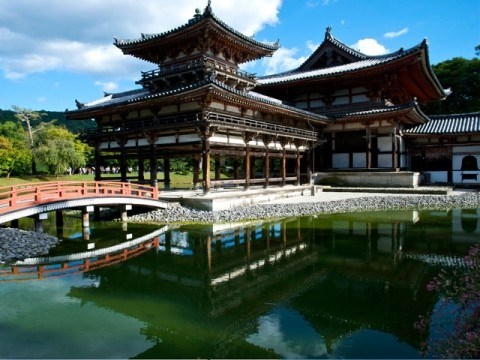While the Japanese city of Kyoto was unaffected by the recent earthquake and tsunami, I can't help wondering if the ancient capital hasn't changed just a little since those terrible events.
I'd visited the city of 1.5 million (two million more if you factor in adjacent Osaka) a few months earlier. And while Kyoto is widely known for its Zen Buddhist temples and gardens, traditional wooden houses, fine arts and crafts, and opportunity to glimpse a geisha, at a wider glance Kyoto is just as modern and frantic as any place else.
That said, one encounters an old and persistent Japanese spirit of hospitality that combines attention to detail with graciousness, termed omotenashi.
For example, the taxi that picked me up at the Osaka-Itami airport provided the epitome of comfort and cleanliness, and the driver, wearing jacket, tie and crisp white cloves, was the model chauffeur. Taxis everywhere are the same. It's an example of omotenashi.
And in the lobby of the Kyoto Hotel Okura stood a massive bouquet of long-stemmed pink lilies, out of which rose shoots of bright orange gladiolus, like a spray of fireworks. So very omotenashi. So very Japanese.
On the other hand, the 2,000 or so remaining Buddhist temples and shrines built when Kyoto served as the imperial capital are now sequestered in the surrounding hills and back streets-even sandwiched among eateries and stores in downtown shopping malls-and out of the way.
Among the best known is the Kiyomizu-dera Temple, spectacularly sited on a forested slope. Another is Rokuon-ji, featuring the famous Golden Pavilion-a three-tier affair rising on the far shore of a vast pond, and appearing the epitome of aesthetic perfection.
But both these sites were crowded with phalanxes of school kids and tourists like me.
I found more tranquility at the Byodo-in Temple in the southern district of Uji. This massive complex, set beside a pond encircled with perfectly pruned trees and gardens, is said to resemble a vast winged phoenix. But what really impressed me about the Byodo-in Temple, a UNESCO World Heritage Site, was its contemporary museum housing exceptional rosewood sculptures of spirited deities, dating to the 11th century.
Back downtown, beyond a modern office tower bearing the name "Nintendo," we slipped into the Kyoto International Manga Museum, a complex of school, library and theatre devoted to the distinctly Japanese style and cult of hand-drawn cartoons and comics.
In this beautifully creaking wood-frame elementary school transformed into a centre for all matters manga, a legion of children and teens (even adults) were sitting on couches, whatever, immersed in some of the museum's 300,000 publications-from action-adventure comics to the books featuring the wildly popular children's character Anpanman.
Lurching back again to the past, the Nishijin Kimono District lies near the former Imperial Palace. Stepping from a flagstone street into an old wooden house or machiya, we entered the rare factory that still uses handlooms to produce silk brocade kimonos and sashes called "obi."
At this fourth-generation family-run business, weavers were bent over wood looms that make a soft click-clacking sound, while drawing on tiny spools of dyed silk. A factory museum shows exceptional kimonos as well as men's ties and fanciful women's purses (but be warned, these fine art pieces are not cheap).
Kimonos of a modest or everyday design are enjoying a revival in Japan, and it's not uncommon to see kimono-clad ladies on the town, or floating through a hotel lobby.
At the Tenryu-ji Temple we faced a serious vegetarian Buddhist lunch. Servers, kneeling at the low tables, delivered dish after exotic dish (with no English explanation) with uncommon grace. The few items I could identify included a roasted chestnut native to this mountain region, aromatic wild mushrooms, and a local eggplant called Kamo. To be honest, it was all a bit strange.
On our final night we dined in the neon-lit Gion district, at a restaurant called Gion Okumura. Seated along a counter presided over by half a dozen chefs, we feasted on a parade of small seafood plates so varied and unrecognizable that I feared for the sea. A small and filleted steak followed-at which point I couldn't eat another bite, although a companion from Hong Kong reported that it was superb. Well-chosen wines accompanied the dinner.
Wherever we went, we were met with style and careful service-omotenashi-and especially when it came to food. The piece de resistance was an event at Hatanaka Ryokan, a traditional inn in the backstreets of Gion, the geisha quarter.
Beyond a wooden gate and shapely stepping-stones, we entered a restaurant where Japanese girls called maiko (literally "dance child") fulfill an apprenticeship to become a full-fledged geisha (or geiko, as they are known here.) In this public setting the maiko perform dances and songs to the accompaniment of a stringed instrument, and then mingle with visitors.
After a multi-course Japanese meal, two maiko-in fanciful kimonos bound at the waist with elaborate obi, their hair coifed and ornamented, and wearing dramatic white and black makeup, with lipstick on the lower lip-stepped onto a stage.
For half an hour, seemingly stiff and formal, they moved and sang in a ritualized way. Then relaxing, they introduced a rock-paper-scissors routine with a bottle of beer to be quaffed by the guest. While playing the game with a young man, 17-year-old Tanefumi laughed with abandon. Through a translator the Tokyo-born teenager then assured us that she happily accepts the confined life she must live to become a geisha.
If she succeeds, she will be one of an increasingly few. And one wonders, in these post earthquake-tsunami days, if the geisha, along with other Japanese traditions, isn't just a little bit closer to disappearing forever.




